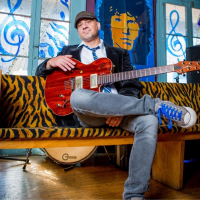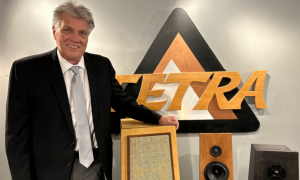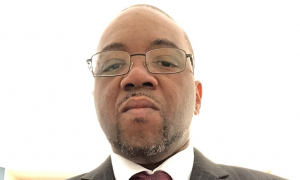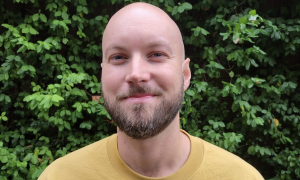Home » Jazz Articles » Chats with Cats » The Jazz Historian: John Edward Hasse
The Jazz Historian: John Edward Hasse

Courtesy Sonya Melescu
I discovered in these travels that many people have a hunger for things from America that are true, uplifting, positive, beautiful, and inspiring. Jazz is that, among the best of American culture. And jazz never hurt anyone.
—John Edward Hasse
To that end, I spoke with John Edward Hasse, a musical historian of the highest order. He has been awarded the title Curator Emeritus by the Smithsonian and is a prolific writer, speaker, and curator. He has travelled the globe teaching the world about the history of jazz but has a deep knowledge about all forms of traditional American music. He explained to me what makes American music unique which might also help explain the impact it's had upon the world. It is important that we have folks like him to remind us of where this music came from, why it's relevant, and how it informs the music of today.
Our conversation contains excerpts from a forthcoming book of his. More info can be found at: johnedwardhasse.com
About John Edward Hasse
John Edward Hasse is a museum curator, speaker, author, pianist, and leader in his field. For 33 years, he served as Curator of American Music at the Smithsonian Institution's National Museum of American History, where he curated exhibitions on Ella Fitzgerald, Frank Sinatra, and Ray Charles, and founded the Smithsonian Jazz Masterworks Orchestra and Jazz Appreciation Month, now celebrated in all fifty states and in forty countries. He is also a former Chairman of Smithsonian Music. Recently, he transitioned from Curator to Curator Emeritus, a lifetime honor, at the Smithsonian.Active in cultural diplomacy for the US State Department, Hasse has lectured on leadership, the arts, and music in twenty countries on six continents. His keynote addresses and lectures appeal to a very broad range of audiences. He has spoken at Harvard University, UCLA and Georgetown University. The Kennedy Center, the Brooklyn Philharmonic, and the Chicago Humanities Festival. The Cleveland Clinic, the American Academy of Nursing, Miami Children's Hospital, and the Health Careers Foundation. State Farm, New York Life, and the World Bank, Leadership Florida, and the Ritz-Carlton Hotel Company. He has also presented at US embassies and consulates in Berlin, Madrid, Prague, Budapest, Buenos Aires, Cairo, Nairobi, and Johannesburg.
He is author of an acclaimed biography, Beyond Category: The Life and Genius of Duke Ellington, with a Foreword by Wynton Marsalis, and editor of Jazz: The First Century, with Forewords by Quincy Jones and Tony Bennett. Hasse is co-author of Discover Jazz and co-producer/co- author of the Jazz: The Smithsonian Anthology. He has contributed to The Washington Post and eight encyclopedias, and writes on music regularly for The Wall Street Journal.
As an expert on American music, he has been interviewed in The New York Times, on CBS Sunday Morning, NPR, PBS, CNN, and many other news outlets.
All About Jazz: I know that you're a pianist. Why did you decide to go into the history side of music rather than the performance side?
John Edward Hasse: I didn't have the dedication and discipline to practice eight hours a day, which is what one of my jazz piano teachers, Sir Roland Hanna, said he did to become the artist he was. I still play the piano, however, and find it gives me insights into the music and the music's history that a non-performer wouldn't possess.
AAJ: As a curator for museums, how do you decide how to distill an artist's career into a small exhibit?
JEH: First comes the question of which musicians to collect. Why do curators and archivists collect? Over the course of my thirty three years at the Smithsonian, what drove my collecting of objects, documents, and audio-visual material?
I collected to preserve the past, help make sense of the present, and create learning opportunities for the future. The importance for history of what we curators do is well articulated by my former colleague, chief archivist John Fleckner: "The task of the historian—whether scholar, journalist, exhibit curator or film maker—is to imagine, recreate, and make meaning of the past. The success of that task relies in great measure on the quality of the surviving documentation, for without that historical record, in its many forms, history becomes mere hearsay."
The first and core responsibility of my job was to build the national collections of musical instruments, scores, parts, sheet music, documents, recordings, films, awards, and memorabilia.
My collecting efforts confronted multiple challenges. Convincing people to let go of their prized possession was often an uphill task. Some resisted because it put them in touch not only with their legacy, but also their mortality. Some resisted because they wanted their stuff at hand for that book they were always going to, but almost never did, write. Some had an unreasonable expectation of financial reward, either an inflated value of their stuff or a mistaken assumption that the Museum had a huge vault of money that we could dip into at will. Others simply couldn't bring themselves to decide. Some felt that a decision about disposition should be left to their children, not understanding the risks of that course.
The primary way a museum curator diffuses knowledge is through exhibitions. Indeed, when most people think of a museum, they conceptualize it as a place to go see stuff on display. That's the way I had thought about museums myself, though I got an on-the-job education that greatly expanded my notion.
As professors teach in classrooms, curators teach most often through museum exhibitions. The Smithsonian curator has, if not the largest, then one of the world's largest "classrooms": these exhibitions can reach millions of visitors per year in a given museum, and countless more in their online version. My exhibitions came to include half a dozen on Duke Ellington, several on jazz photography, and exhibits on Frank Sinatra, Ella Fitzgerald, Ray Charles, and the history of the piano.
An exhibit must project a central thesis, the one thing that visitors should retain, and at maximum, three other main points, because most people are not capable of remembering more than that. Curators bear in mind that an exhibition cannot offer nearly the detail of a book, a reference work, a documentary film, or a website. In a history museum, an exhibition is a collection of objects arranged to tell an important story, perhaps raise questions in the visitors' minds, and ideally stimulate a desire to learn more. The scholarship must be up to date, the objects worth a trip to see, the design conducive to large crowds moving but not clogging the pathways.
AAJ: Why is it so important for people to know about these artists that you speak and write about?
JEH: These musicians are some of the most distinctive, creative, and accomplished artists this country has produced. Not only is their music of enduring worth on aural, emotional, and ideational grounds, but their music expresses such fundamental values as creativity, innovation, individuality, and risk-taking. Their life stories are often inspirational. Duke Ellington, Louis Armstrong, Charlie Parker, Ella Fitzgerald, Miles Davis, John Coltrane, and Lester Young are musical heroes of mine and, I daresay, many others too.
AAJ: Did I read correctly that you founded Jazz Appreciation Month?
JEH: Yes, that's true. Here's how it happened:
Troubled by the underappreciation of jazz in the country of its origin, in 1997, I conceived the idea of a national "month" for jazz, and decided it should be named Jazz Appreciation Month or, for short, JAM. As I saw it, the fundamental problem facing jazz was not a shortage of talented performers, but a lack of audience, too few listeners and fans to sustain the musicians and the music. So, I wanted JAM primarily to help grow the audience for jazz.
I approached the International Association of Jazz Educators, then the largest jazz organization in the world, with the idea of starting Jazz Appreciation Month. I proposed it be held during April for educational reasons: April gave school ensembles nearly the entire school year to prepare and play at their best. The small full-time IAJE staff of five felt it didn't have the resources to mount this initiative. The Executive Director told me, though, that if the Museum started it, he'd get right behind us and support it. To my knowledge, starting a national "month" was unprecedented at the Smithsonian and because the Institution was far larger and more complex than his staff of five, I knew that starting it through the Museum would not be a snap.
And yet no manager or leader in the Museum or Smithsonian told me "No, you can't do that: we don't want you spending your time on that," or "You'll never succeed" or "This isn't a proper thing for the Smithsonian to do, we have no experience at this, let some other organization establish it." Here was another example of my having great freedom within the broad parameters of my job description, to decide my own work priorities. The people who led the Museum tended to hire curators very carefully and then assume that each expert would have the judgment to pursue what was important. In this environment, I thrived.
Once I started talking up the idea in the jazz community, a proposal popped up that JAM start as a commercial, music industry undertaking. But my mentor David Baker, my former professor at Indiana University and then maestro of the Smithsonian Jazz Masterworks Orchestra, and other leaders I respected agreed that this celebration would need to get off the ground as an educational and cultural, not commercial, celebration. That's where I set my course and threw everything I had into establishing it as on ongoing annual event.
I took as inspiration the great success of Black History Month. I learned that Carter G. Woodson, a Harvard PhD who founded the Association for the Study of Negro Life and History, established Black History Month in 1926 in Washington, D.C. For its first fifty years, it was known as Negro History Week. In 1976 it expanded into an entire month. Educational and cultural institutions throughout the United States have since embraced it. At its heart, Black History Month is affirming, informative, educational, community-based (no one from Washington dictates orders to the rest of the country), grassroots (no one from DC hands out big bundles of money), and non-commercial.
By the close of the 20th century, Black History Month had become deeply rooted in the public's consciousness: schoolchildren across America knew about it and participated in assignments and programs—public radio and TV stations broadcast programs and concert halls and libraries got involved. By raising awareness of the central contributions of African Americans to the history and culture of the United States, Black History Month has done a tremendous service to the body politic, the educational system, and Americans' sense of national identity.
So successful had Black History Month become that many American institutions now recognize such other designated months as Hispanic Heritage Month, Asian-Pacific Heritage Month, National American Indian Heritage Month, and Women's History Month, among others.
As I thought about Black History Month, I felt that JAM should likewise have an altruistic essence; and that integrity would serve to build awareness, credibility, respect, and participation by the educational and cultural sectors. Jazz, I felt, should be recognized and celebrated every month of the year, but designating a month for it, I reasoned, could provide a focus for awareness, a hook for the news media, and a platform for a nationwide celebration.
JAM has grown to be celebrated in all fifty states and forty other countries. Readers can find more information, radio PSAs, and JAM posters online at Smithsonian Jazz.
AAJ: Are there any egregious historical misperceptions that people have about jazz that you try to correct?
JEH: Yes. Jazz, according to popular lore, was born and raised in Storyville, the New Orleans redlight district. When the U.S. Navy forced the area's closure in 1917, jazz musicians left the city and took the new music up the Mississippi River to Chicago. From there it spread across the nation.
Is that the way jazz actually came into being? Well, not really. This widely embraced notion is freighted with five misconceptions about where the music started, about where it was played in New Orleans, about when the exodus of jazz musicians began and why, about their journey north, and about their pathways out of New Orleans.
Jazz did not originate in Storyville, and it was played not only in the red-light "District" but all over New Orleans. Some musicians left New Orleans long before 1917, while others didn't leave for a number of years or never left. None of the adventurers took the Mississippi River to Chicago (it doesn't go anywhere near Chicago!); some of the musicians who left went north, some went west to California, and others toured widely.
Another fallacy is that word "jazz" is sexual in origin. Evidence, however, points to baseball as the origin of the word. Probably the first documented use of "jazz" appeared in a 1912 Los Angeles Times article about baseball.
AAJ: Do you have a favorite musician?
JEH: Duke Ellington! He was always pushing against conventions and limits. Ostensibly a dance band leader, he created an enormous, innovative, and nonpareil body of compositions and recordings that still holds wonders for the listener. He treated his band's rehearsals as a musical laboratory, experimenting with new harmonies, timbres, and instrumental voicings. Like a magisterial chef, he alchemized his ingredients, the signature styles of his musicians, into a whole that was greater than the sum of its parts.
Unlike other great bandleaders, Ellington personally created most of the music played by his orchestra and composed exclusively for it. He was the supreme creator of music for that essential American institution, the jazz orchestra or big band. A wizard of experiment, he developed his own harmonic language and tone colors, also known as timbres, the characteristic sounds of a note played on different instruments.
By the time he was 30, Ellington had developed a singular composing voice and style built around the distinctive gifts of each individual band member. With characteristic musical sensitivity, he wrote pieces that were designed for specific players in his ensemble. He didn't write for unknown trumpet or trombone, but for the signature sounds, for example, of his trumpeter Arthur Whetsol and his trombonist Tricky Sam Nanton, mixing their colors like a master painter. In transforming disparate individuals into a unique group sound and personalizing the orchestra, Ellington (as a Stockholm reviewer wrote in 1939) created "orchestral art of the highest order." By combining instruments in novel ways and writing unusual lines for them, he created musical tone colors never heard before.
Part of Ellington's genius was his ability to mix the sounds of his players like a master painter mixes pigments. Ellington's nephew, who knew him well, asserts that his uncle had a brain anomaly known as synesthesia: "He heard sounds as colors and colors as sounds." Ellington's longtime musical collaborator, Billy Strayhorn, famously said "Ellington plays the piano, but his real instrument is his band. Each member of his band is to him a distinctive tone color and set of emotions, which he mixes with others equally distinctive to produce a third thing, which I like to call the Ellington Effect." Ellington himself once said, "I hear a note by one of the fellows in the band and it's one color. I hear the same note played by someone else and it's a different color. When I hear sustained musical tones, I see just about the same color as you do, but I see them in textures. If [baritone saxophonist] Harry Carney is playing, D is dark blue burlap. If [alto saxophonist] Johnny Hodges is playing G becomes light blue satin." As a hobby, Ellington dabbled in painting. His favorite color was blue, whose hues showed up in a number of his compositions like "Mood Indigo," "Azure," "Blue Light," "Blue Serge," "Transblucency," "On a Turquoise Cloud," and others.
In a career spanning five decades, he overcame one racial barrier after another in night clubs, theaters, and motion pictures, and added hundreds of musical treasures to our national heritage. I find his story and legacy deeply inspiring.
AAJ: You have received many commendations including two Grammy nominations and the title Curator Emeritus of American Music. Are there any other achievements you're still striving for?
JEH: I like to be always working on a book, even if it takes many years. One of the books I'm developing is a collection of my cultural commentaries published in The Wall Street Journal. Since 2008, I have written a musical commentary every month or so, on average, about many of the great figures in jazz, from Louis Armstrong to Miles Davis—masterpieces ranging from [Armstrong's] West End Blues (Okeh, 1928) to [Davis']Bitches Brew (Columbia, 1970). And about milestones such as the birth of the radio broadcasting and the invention of the vinyl LP.
I view my writing for the newspaper as "musical missionary" work, reaching to investors, businesspeople, and corporate officials who may not be jazz fans at all and gently bringing them inside the large and wondrous tent of jazz. Then sending them right out to listen to the musicians I was discussing. And with luck, drawing them back for a future article. After leaving the museum, it became my most satisfying form of writing and outreach.
The Smithsonian curator works in an enormous classroom—about five million people walk through the doors of the American History Museum every year. Someone whose writing appears in The Wall Street Journal teaches in a huge classroom, too, as the circulation averages over two million people per day, as of today, the second-largest circulation of any newspaper in the United States. I felt very gratified about spreading the gospel, so to speak, to those who read the Journal.
AAJ: You're an authority on all kinds of American music. What do you think makes American music different and why?
JEH: Music born in America sounds different than music born in Europe, or Africa, or Asia. This is the result of, first of all, population movements: immigration from Europe, forced migration, chattel slavery, from Africa, and later, migration from Latin America and Asia. And second, from the dynamic nature of our society and culture, where a musical style will come up against another style and often produce a third style. Where there is constant churn and change. Since its early days, American culture has been anything but static.
AAJ: You've lectured around the world representing the U.S. State Department. How do you find the reception internationally? What are people most curious about?
JEH: Considering the power of jazz to express such powerful American values as freedom, democracy, and cultural diversity, I was both surprised and elated when in 2001, out of the blue, I received a phone call from a State Department officer inviting me to go to Spain, on short notice, to lecture on American jazz. I wondered to myself, "Why the heck did they call me rather than an African American writer or academic expert?" Probably they had, but the speaker had dropped out at the last minute, and I was their second, third, or fourth choice!
The museum gave me permission to go, in effect, lending me to the State Department for a few days. In quick succession, I gave six lectures in Madrid and Barcelona, supported by the US Embassy/Madrid and the US Consulate/Barcelona. Though I had lectured to specialist groups in other countries, this was my first occasion to officially represent the United States, to conduct a bit of cultural diplomacy. I was thrilled at the opportunity to engage people across the boundaries of nationality and language, and to shine a spotlight on some of America's proudest artistic contributions. This experience was a highlight of my year.
Each time, I found it moving to engage people across the boundaries of nationality and language, to enhance understanding, and to build friendships. I was elated to do my tiny part to bridge cultural differences, and to shine a spotlight on some of America's proudest artistic contributions. It's been fascinating to learn how people from other cultures and musical traditions have come to appreciate American music.
Cultural diplomacy was a tiny part of my work, not even mentioned in my job description. Each trip was a quick zip over and back, the usual duration was two or three days. I was jet-lagged the entire time, not at my best, but I always tried my hardest to make a good impression for the US, for the Smithsonian, and for the music. I never considered myself as a representative of or spokesman for African American culture, but rather as an observer, historian, and advocate, passionate and deeply admiring of its accomplishments.
In 2006, the State Department's Speaker Program sent me to South Africa, followed in later years by trips to Ethiopia, Kenya, Zambia, Mauritius, Egypt, Germany, Latvia, Estonia, Hungary, Slovakia, Romania, Montenegro, and Turkey. I loved doing my small part to bridge cultural differences, enhance understanding, build friendship, and inform people about the history of American music. And it was fascinating to learn how people from other cultures and musical traditions came to appreciate American jazz.
In every African nation where I spoke, the most beloved American jazz musician was, hands-down, Louis Armstrong. In both Nairobi, Kenya, and Lusaka, Zambia, speaking on behalf of the US Embassies, I gave illustrated presentations on the life and music of Louis Armstrong. Even half a century after his death, through recordings and films, he radiated excellence, humanity, and joy. In Lusaka, Zambia, a young musician came up to me afterward and said, "Life will never be the same again." In Nairobi, a young man came and said, "You've changed my life forever." I took their elation to mean that Louis Armstrong had transformed their lives, and that still makes me beam with delight.
In Alexandria, Egypt, after I spoke about Armstrong to a group of adult Egyptians, an elderly woman, wearing a traditional headscarf, nodded at me. She didn't speak English, but she smiled broadly and said "Sucre," the Arabic word for sugar. Again, I took that as a compliment for Armstrong. Prior to him, the world had never heard trumpet playing or singing like his. And after seven decades, it was still new and exciting to these young African men and this elder Egyptian woman.
When I went to South Africa in 2006, a group of young boys, many of them orphans, traveled an hour and a half from their township of tin-roofed shacks to hear me speak. And when I began to play a recording of Armstrong's "Hello, Dolly!" three of the boys sang along. They knew the words, every single one! I was just floored. Armstrong, who was born more than a century earlier in a country halfway around the world, and his music were able to leap with ease over geography, nationality, culture, and generations to communicate and inspire young people. To me, that was deeply moving.
Without pretending that we are perfect or without serious problems, I discovered in these travels that many people have a hunger for things from America that are true, uplifting, positive, beautiful, and inspiring. Jazz is that, among the best of American culture. And jazz never hurt anyone. Unlike some more recent styles of pop music, there are no misogynistic, lewd, vulgar, or violent aspects to the music. Jazz, I believe, represents some of the best qualities of the United States.
AAJ: How do you think the plight of modern jazz musicians compares to that of the jazz pioneers?
JEH: The main things a jazz musician wants are to: express themselves as they see fit, work with bandmates who mesh well, perform for audiences who respect and hunger for their art, and enjoy the financial security, a dependable livelihood, to do all these things. That was true in 1923 and it's true in 2023.
Of course, so many things have changed in the course of one century: communications media, the technology of recording and transmission, the efficiency of travel, new ways for the public to spend its leisure time and disposable income, and the kinds of venues and "musical occasions" (parades, dances, stage shows, night clubs, concerts, festivals).
The biggest change is that of law and custom in the way the majority population treats minorities. So much improvement, yet so much more must be done about the pain and injustice. Rectification will need to be made as far into the future as anyone of us can imagine. And that makes me think of the words of Dr. Martin Luther King, Jr.: "The arc of the moral universe is long, but it bends towards justice."
Tags
Chats with Cats
B.D. Lenz
United States
Ella Fitzgerald
frank sinatra
Ray Charles
Berlin
Madrid
Prague
Budapest
buenos aires
Cairo
Nairobi
Johannesburg}.
He is author of an acclaimed biography, Beyond Category: The Life and Genius of Duke Ellington, with a Foreword by {{m: Wynton Marsalis Quincy Jones Tony Bennett Roland Hanna duke ellington Louis Armstrong Charlie Parker Miles Davis John Coltrane Lester Young David Baker Smithsonian Jazz Masterworks Orchestra New Orleans Chicago Arthur Whetsol Stockholm Billy Strayhorn Harry Carney Johnny Hodges Barcelona Lusaka Alexandria
He is author of an acclaimed biography, Beyond Category: The Life and Genius of Duke Ellington, with a Foreword by {{m: Wynton Marsalis Quincy Jones Tony Bennett Roland Hanna duke ellington Louis Armstrong Charlie Parker Miles Davis John Coltrane Lester Young David Baker Smithsonian Jazz Masterworks Orchestra New Orleans Chicago Arthur Whetsol Stockholm Billy Strayhorn Harry Carney Johnny Hodges Barcelona Lusaka Alexandria
PREVIOUS / NEXT
Support All About Jazz
 All About Jazz has been a pillar of jazz since 1995, championing it as an art form and, more importantly, supporting the musicians who make it. Our enduring commitment has made "AAJ" one of the most culturally important websites of its kind, read by hundreds of thousands of fans, musicians and industry figures every month.
All About Jazz has been a pillar of jazz since 1995, championing it as an art form and, more importantly, supporting the musicians who make it. Our enduring commitment has made "AAJ" one of the most culturally important websites of its kind, read by hundreds of thousands of fans, musicians and industry figures every month.























